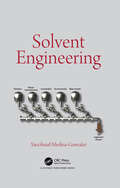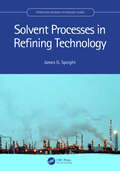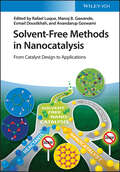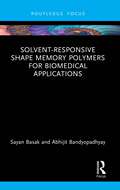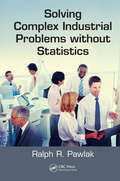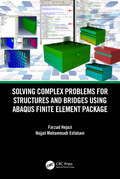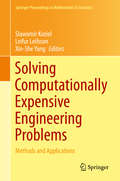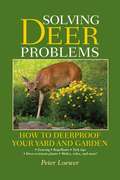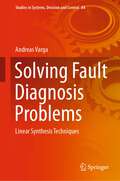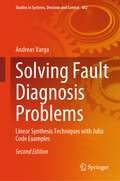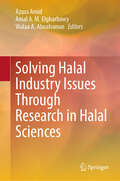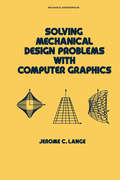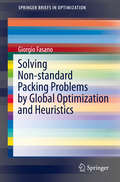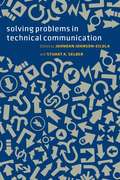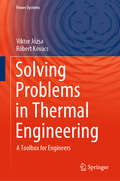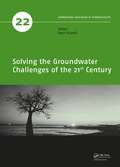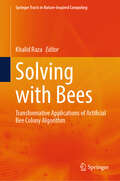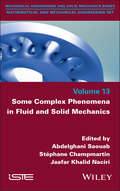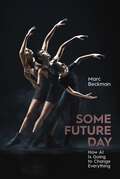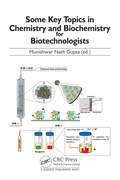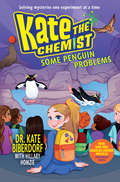- Table View
- List View
Solvent Engineering
by Yaocihuatl Medina-GonzalezThis book aims to present the concept of Solvent Engineering within a broad scope, ranging from mixtures of solvents to achieve the desired solvation properties, to stimuli-responsive solvents. It covers diverse aspects such as thermodynamics and transfer phenomena associated with solvent engineering, as well as applications found in recent literature, spanning materials across science, biochemistry, chemistry, and separation and purification processes, among others. Solvent engineering is proposed as an innovative strategy to address environmental concerns related to the use of volatile and toxic solvents. This book highlights efforts to develop engineered solvents that offer more environmentally acceptable alternatives as against those currently in use.
Solvent Processes in Refining Technology (Petroleum Refining Technology Series)
by James G. SpeightThis book focuses on the various solvent processes that are used in crude oil refineries. It presents the differences between each type of process and discusses the types of feedstock that can be used for the processes. This accessible guide is written for managers, professionals, and technicians as well as graduate students transitioning into the refining industry. . Key Features: • Describes the various steps that are necessary for the solvent treatment of various feedstocks in crude oil refineries. Brings the reader up to date and adds more data. Provides an extensive glossary. Considers next-generation processes and developments.
Solvent-Free Methods in Nanocatalysis: From Catalyst Design to Applications
by Rafael Luque Manoj B. Gawande Esmail Doustkhah Anandarup GoswamiSolvent-Free Methods in Nanocatalysis Discover solvent-free approaches for the synthesis of nanocatalysts as well as various catalytic transformations in this unique one-stop resource Solvent-free methods have attracted wide attention in organic synthesis and catalysis as a promising approach towards “greener” and more sustainable chemical transformations. In this regard, nanocatalysis has seen particular growth in recent years. Solvent-Free Methods in Nanocatalysis gives an in-depth overview of nanocatalysts and their catalytic applications using solvent-free methods. After a brief introduction, it covers various synthetic techniques for the preparation of nanocatalysts and supports using solvent-free methods, e.g. ball-milling, microwave- and plasma-assisted methods. The book discusses in detail different catalyst classes, such as metal oxides, doped and functionalized nanocarbons, as well as nitride- and silica-based materials to help researchers to understand the efficiency and nature of these catalysts/supports based on their chemical structure. In the book readers will also find: A brief account of the history, challenges, and recent advances in the field Detailed discussion of advantages and disadvantages of solvent-free techniques for nanocatalyst preparation Treatment of important solvent- and catalyst-free organic transformations (i.e. oxidation, coupling and multicomponent reactions) A chapter on supported ionic liquids for solvent-free catalysis Written by leading researchers in the field, Solvent-Free Methods in Nanocatalysis is a useful reference for researchers and students working in organic synthesis, catalysis, and nanomaterials science.
Solvent-Responsive Shape Memory Polymers for Biomedical Applications
by Abhijit Bandyopadhyay Sayan BasakThis book explains the intricacies of one-way shape memory polymers (SMPs), with a particular emphasis on solvent-responsive SMPs focusing on fundamental pathways and key principles crucial to the development of these materials. The subsequent section homes in on the specific realm of solvent-responsive SMPs, highlighting the potential advantages these polymers offer and critical evaluation of existing shortcomings and research gaps. It further explains how solvent-responsive SMPs aim to address challenges and advancements within the biomedical industry.Features: Delve into the latest developments and research findings on solvent-responsive shape memory polymers. Explore practical and real-world applications of solvent-responsive shape memory polymers in the biomedical domain. Provide an understanding of these polymers from molecular to macroscopic levels. Explore the underlying physics, chemistry, and thermodynamics that govern the mechanism of solvent-driven shape change in these polymers. Review innovations in the design of solvent-responsive shape memory polymers and their applications across a variety of industrial fields. Examine how solvent-responsive shape memory polymers can be integrated and applied across different scientific disciplines. This book is aimed at graduate students and researchers in polymer engineering, materials science, and bioengineering.
Solving Complex Industrial Problems without Statistics
by Ralph PawlakPresenting: Problem Solving Sans Statistics Enhance your problem-solving skills, and improve your company’s profitability using the methods outlined in Solving Complex Industrial Problems without Statistics. Introducing a process that involves working through problems and solutions without relying on complicated statistical design or analysis, this book pulls away from data-driven thinking and provides the problem solver with a new way of solving problems. Utilizing techniques that have been applied in facilities throughout the U.S., Canada, Italy, China, and Hong Kong, it demonstrates the use of process and problem differences and similarities, and provides a better understanding of analogous comparisons. The book incorporates visual analysis tools and problem examples in a format that facilitates comprehension and learning, presents novel concepts that do not require numbers or statistics, and provides a better understanding of the solution system/process overall. Each chapter presents new information, as well as case studies that include: Different problem situations Short histories detailing the operation, condition, and circumstances that were present at the time of each study Photographs, sketches, or tables with simple explanations to describe the circumstances, conditions, and the actions taken Methods of solution in rudimentary form Chapter summaries to review important mechanisms and workings Final summaries to tie together the important methods and techniques that facilitate easy problem solutions Solving Complex Industrial Problems without Statistics provides valuable insight into the solution of complex quality and manufacturing problems, without the use of statistics, and is essential to anyone involved in quality, control, problem-solving activities, or total quality management.
Solving Complex Problems for Structures and Bridges using ABAQUS Finite Element Package
by Farzad Hejazi Hojjat Mohammadi EsfahaniThis book aims to present specific complicated and puzzling challenges encountered for application of the Finite Element Method (FEM) in solving Structural Engineering problems by using ABAQUS software, which can fully utilize this method in complex simulation and analysis. Therefore, an attempt has been to demonstrate the all process for modeling and analysis of impenetrable problems through simplified step by step illustrations with presenting screenshots from software in each part and also showing graphs. Farzad Hejazi is the Associate Professor in the Department of Civil Engineering, Faculty of Engineering, University Putra Malaysia (UPM), and a Senior Visiting Academic at the University of Sheffield, UK. Hojjat Mohammadi Esfahani,an expert on Finite Element Simulation,has more than 10 years of experience in the teaching and training of Finite Element packages, such as ABAQUS.
Solving Computationally Expensive Engineering Problems
by Leifur Leifsson Slawomir Koziel Xin-She YangComputational complexity is a serious bottleneck for the design process in virtually any engineering area. While migration from prototyping and experimental-based design validation to verification using computer simulation models is inevitable and has a number of advantages, high computational costs of accurate, high-fidelity simulations can be a major issue that slows down the development of computer-aided design methodologies, particularly those exploiting automated design improvement procedures, e. g. , numerical optimization. The continuous increase of available computational resources does not always translate into shortening of the design cycle because of the growing demand for higher accuracy and necessity to simulate larger and more complex systems. Accurate simulation of a single design of a given system may be as long as several hours, days or even weeks, which often makes design automation using conventional methods impractical or even prohibitive. Additional problems include numerical noise often present in the simulation data, possible presence of multiple locally optimum designs, as well as multiple conflicting objectives. In this edited book, various techniques that can alleviate solving computationally expensive engineering design problems are presented. One of the most promising approaches is the use of fast replacement models, so-called surrogates, that reliably represent the expensive, simulation-based model of the system/device of interest but they are much cheaper and analytically tractable. Here, a group of international experts summarize recent developments in the area and demonstrate applications in various disciplines of engineering and science. The main purpose of the work is to provide the basic concepts and formulations of the surrogate-based modeling and optimization paradigm, as well as discuss relevant modeling techniques, optimization algorithms and design procedures. Therefore, this book should be useful to researchers and engineers from any discipline where computationally heavy simulations are used on daily basis in the design process.
Solving Deer Problems: How to Deerproof Your Yard and Garden (Lyons Press Ser.)
by Peter LoewerWhat can I do? Gardeners are asking themselves--and experts--this question with increasing urgency about the deer that threaten their carefully cultivated lawns and gardens. With the increased development of suburban and rural land and the lack of natural predators, deer populations are exploding and living closer to humans than ever before--and they’re nibbling on more beloved blooms as well. How can the deer be stopped? What plants are safe? Peter Loewer has the answers in Solving Deer Problems. In this manual, he addresses several key topics, including plants that will withstand a whitetail attack, chemicals that can safely be used as deer repellants, fences that will keep deer away from those choice garden beds, trapping and relocating cervids and other garden pests, and numerous tricks to keep the pesky creatures out of your yard. Peter also discusses the less-prominent threat of deer-borne diseases and ticks and how to protect yourself and your pets. He even touches on car vs. deer collisions and how you can prepare yourself to achieve the best outcome incase a deer is ever caught in your headlights. Don’t wait until your prize flowers, vegetables, or shrubs are a deer’s meal. Pick up Solving Deer Problems for all the clear answers on what you can do about your deer problem.
Solving Fault Diagnosis Problems: Linear Synthesis Techniques (Studies in Systems, Decision and Control #84)
by Andreas VargaThis book addresses fault detection and isolation topics from a computational perspective. Unlike most existing literature, it bridges the gap between the existing well-developed theoretical results and the realm of reliable computational synthesis procedures. The model-based approach to fault detection and diagnosis has been the subject of ongoing research for the past few decades. While the theoretical aspects of fault diagnosis on the basis of linear models are well understood, most of the computational methods proposed for the synthesis of fault detection and isolation filters are not satisfactory from a numerical standpoint. Several features make this book unique in the fault detection literature: Solution of standard synthesis problems in the most general setting, for both continuous- and discrete-time systems, regardless of whether they are proper or ¬ consequently, the proposed synthesis procedures can solve a specific problem whenever a solution exists Emphasis on the best numerical algorithms to solve the synthesis problems for linear systems in generalized state-space form (also known as descriptor systems) Development of general synthesis procedures relying on new computational paradigms, such as factorization-based design based on filter updating techniques and nullspace-based synthesis Availability of a comprehensive set of free accompanying software tools for descriptor systems, which allows readers to easily implement all synthesis procedures presented in the book and ensures that all results are reproducible This book is primarily intended for researchers and advanced graduate students in the areas of fault diagnosis and fault-tolerant control. It will also appeal to mathematicians with an interest in control-oriented numerics.
Solving Fault Diagnosis Problems: Linear Synthesis Techniques with Julia Code Examples (Studies in Systems, Decision and Control #482)
by Andreas VargaThe goal of this new edition is the same as for the first edition ”to address the fault detection and isolation topics from a computational perspective“, by covering the same important aspects, namely, (1) providing a completely general theoretical treatment of fault and model detection problems for linear time-invariant systems; (2) presenting the best suited numerical approaches to solve the specific computational problems; (3) providing supporting software to solve the analysis and filter synthesis problems. In this second edition, the changes in the theoretical presentation are minor and all known errors and typos have been corrected. The major difference to the first edition is in the underlying computational support, which is now based on software developed in a relatively new language called Julia. The presentation of synthesis procedures and examples is similar to the first edition, but it is now interlaced with Julia codes which can be used to reproduce all computational examples and figures presented in the book. An Appendix has been added to cover some basic issues related to using Julia and the new FaultDetectionTools and DescriptorSystems packages.
Solving Halal Industry Issues Through Research in Halal Sciences
by Azura Amid Amal A. M. Elgharbawy Walaa A. AbualsununThis book serves as a platform for the global community of halal researchers to share their insights on approaches to solve halal industry issues through science. The global halal industry is estimated to be worth around USD2.3 trillion (excluding Islamic finance). Growing at an estimated annual rate of 20%, the industry is valued at about USD560 billion a year, making it one of the fastest-growing consumer segments in the world. The global halal market of 1.8 billion Muslims is no longer confined to food and food-related products. This book brings together research carried out through halal sciences to solve issues in halal industries, covering topics such as general issues in halal industries, the level of verification and authentication, finding alternative materials or ingredients that are halal in pharmaceutical and food industries, as well as legal issues that could arise. This book is useful to graduate students in universities, researchers, academics, and industry practitioners working in halal industries.
Solving Mechanical Design Problems with Computer Graphics
by Jerome LangeThis book acquaints the reader with interactive computer graphics and how they are being used in the analysis of mechanical design problems. It covers four mechanical design topics: the graphics model, mass properties, stress and strain, and kinematic and kinetic analysis.
Solving Non-standard Packing Problems by Global Optimization and Heuristics
by Giorgio FasanoThis book results from a long-term research effort aimed at tackling complex non-standard packing issues which arise in space engineering. The main research objective is to optimize cargo loading and arrangement, in compliance with a set of stringent rules. Complicated geometrical aspects are also taken into account, in addition to balancing conditions based on attitude control specifications. Chapter 1 introduces the class of non-standard packing problems studied. Chapter 2 gives a detailed explanation of a general model for the orthogonal packing of tetris-like items in a convex domain. A number of additional conditions are looked at in depth, including the prefixed orientation of subsets of items, the presence of unusable holes, separation planes and structural elements, relative distance bounds as well as static and dynamic balancing requirements. The relative feasibility sub-problem which is a special case that does not have an optimization criterion is discussed in Chapter 3. This setting can be exploited by introducing an ad hoc objective function, aimed at facilitating the finding of integer-feasible solutions. The third chapter also discusses the issue of tightening the general MIP model by introducing valid inequalities. A MIP-based heuristic approach is developed in Chapter 4, where the basic concept of abstract configuration is presented. Chapter 5 is devoted to experimental results relevant to a real-world application framework. Chapter 6 adopts both extensions of the general MIP model and non-linear formulations to tackle two further non-standard packing issues. The final Chapter 7 presents conclusions and provides insights regarding prospective developments (including non-standard scheduling aspects). Practitioners and researchers interested in advanced optimization model development and solution in the context of logistics, transportation systems, complex structures, manufacturing and electronics will find this book useful. The book can also be used in graduate courses on nonlinear - including global and mixed integer - optimization, as a valuable collection of practically meaningful object packing applications.
Solving Pavement and Construction Materials Problems with Innovative and Cutting-edge Technologies: Proceedings of the 5th GeoChina International Conference 2018 – Civil Infrastructures Confronting Severe Weathers and Climate Changes: From Failure to Sustainability, held on July 23 to 25, 2018 in HangZhou, China (Sustainable Civil Infrastructures)
by Zahid Hossain Jiupeng Zhang Can ChenThis book presents challenges in transportation engineering, recent developments and advancements in technologies, and design and construction using sustainable materials. The articles presented in this volume focus on fundamental investigations on various aspects of civil engineering materials and structures. The scope of this volume is the application of findings for solving problems in geotechnical, pavement, and transportation engineering using emerging techniques. Papers were selected from the 5th GeoChina International Conference 2018 on Civil Infrastructures Confronting Severe Weathers and Climate Changes Conference, held on July 23 to 25, 2018 in HangZhou, China.
Solving Problems in Technical Communication
by Stuart A. Selber Johndan Johnson-EilolaThe field of technical communication is rapidly expanding in both the academic world and the private sector, yet a problematic divide remains between theory and practice. Here Stuart A. Selber and Johndan Johnson-Eilola, both respected scholars and teachers of technical communication, effectively bridge that gap. Solving Problems in Technical Communication collects the latest research and theory in the field and applies it to real-world problems faced by practitioners--problems involving ethics, intercultural communication, new media, and other areas that determine the boundaries of the discipline. The book is structured in four parts, offering an overview of the field, situating it historically and culturally, reviewing various theoretical approaches to technical communication, and examining how the field can be advanced by drawing on diverse perspectives. Timely, informed, and practical, Solving Problems in Technical Communication will be an essential tool for undergraduates and graduate students as they begin the transition from classroom to career.
Solving Problems in Thermal Engineering: A Toolbox for Engineers (Power Systems)
by Viktor Józsa Róbert KovácsThis book provides general guidelines for solving thermal problems in the fields of engineering and natural sciences.Written for a wide audience, from beginner to senior engineers and physicists, it provides a comprehensive framework covering theory and practice and including numerous fundamental and real-world examples. Based on the thermodynamics of various material laws, it focuses on the mathematical structure of the continuum models and their experimental validation. In addition to several examples in renewable energy, it also presents thermal processes in space, and summarizes size-dependent, non-Fourier, and non-Fickian problems, which have increasing practical relevance in, e.g., the semiconductor industry. Lastly, the book discusses the key aspects of numerical methods, particularly highlighting the role of boundary conditions in the modeling process.The book provides readers with a comprehensive toolbox, addressing a wide variety of topics in thermal modeling, from constructing material laws to designing advanced power plants and engineering systems.
Solving the Groundwater Challenges of the 21st Century (IAH - Selected Papers on Hydrogeology)
by Ryan VogwillGroundwater is integral to many human and environmental systems but there are significant challenges in dealing with the impact of anthropogenic activities on groundwater systems. These challenges need innovative solutions. This book contains a wide range of content, from a discussion of the Australian regulatory framework for unconventional hydroc
Solving with Bees: Transformative Applications of Artificial Bee Colony Algorithm (Springer Tracts in Nature-Inspired Computing)
by Khalid RazaThis book is a comprehensive volume, which delves into the versatile world of Artificial Bee Colony (ABC) algorithms, their variants, and myriad applications in a wide range of fields. This book is designed to be an essential resource for researchers, practitioners, students, and anyone intrigued by the fascinating realm of swarm intelligence and optimization. This book serves as a bridge between the theoretical foundations of ABC algorithms and their practical implementations across diverse domains. The book offers a deep understanding of these algorithms and how they can be harnessed to tackle complex real-world challenges.
Some Complex Phenomena in Fluid and Solid Mechanics (ISTE Consignment)
by Abdelghani Saouab Stéphane Champmartin Jaafar Khalid NaciriThis book is a tribute to Professor Abdelhak Ambari and brings together ten chapters written by colleagues who were fortunate enough to work with him. The contributions presented in this book cover the research themes in which Abdelhak Ambari was interested, and to which he made valuable experimental and theoretical contributions. For example: rheology of complex fluids and polymers; hydrodynamic interactions; flows at low Reynolds numbers; characterization of porous media; hydrodynamic instabilities and solid mechanics; electrochemical metrology. Some Complex Phenomena in Fluid and Solid Mechanics is aimed at a wide community of readers wishing to delve deeper into these scientific themes: since it is oriented toward the world of research, it will be a valuable tool for doctoral students and beyond. The book also provides undergraduate and graduate students with a good introduction to the techniques and approaches developed in fundamental and applied research in the fields of fluid mechanics, solid mechanics and instrumentation.
Some Dreams Are Nightmares
by James GunnThese stories share a common concept: man has dreamed for centuries about space flight, about happiness, about immortality. If only I could fly to the moon, he has told himself, if only I could find true happiness, if only I could live forever ... then I would be like a god. These stories, however, go on to demonstrate that every dream come true brings unforeseen consequences. The power of man to dream and make his dreams come true is unlimited, but each step forward must be paid for, there is no such thing as a free lunch, and some dreams are nightmares.
Some Future Day: How AI Is Going to Change Everything
by Marc BeckmanThis cutting-edge guide not only shows how AI is transforming our careers, lives, businesses, and more, but also provides easy, actionable steps to make AI work for us. In this groundbreaking book, celebrated professor, entrepreneur, author, and podcaster Marc Beckman explores the transformative power of artificial intelligence (AI) and how it&’s poised to enhance and transform all aspects of society—revolutionizing our careers, enriching our family lives, and bringing our communities closer together. From business and advertising, to medicine, to warfare, to politics—Beckman meticulously explores the different areas where we&’ll soon feel AI&’s transformative impact. But that&’s only half of it. Throughout this book, he also provides the specific steps readers can take now to make sure these coming changes work for them. From the workplace to the home, AI is poised to reshape the way we approach our professional and personal lives. Beckman uses this book to make the case that AI will free up valuable time and energy, allowing individuals to focus on more creative and meaningful work, but also that AI will create possibilities for engagement that were unthinkable just a generation ago. He shows that with AI as our co-pilot, we&’ll unlock new opportunities for growth, innovation, and collaboration—all of which will lead to more fulfilling and rewarding careers. Beckman illustrates how AI will strengthen family bonds and improve the quality of our home lives too, changing everything from how we educate our kids to how we stay connected on social media. And as AI becomes more integrated into our cities and towns, it will play a crucial role in fostering a sense of community and belonging; through AI-powered platforms, Beckman shows how we will collaborate on projects, share resources, and support one another in times of need. This thought-provoking and essential book is a definitive guide to the many ways in which AI will transform our lives for the better . . . but also surprise us, delight us, force us to (re)consider how we interact with one another, and make us question what exactly counts as &“human.&” Join Marc Beckman on this exciting journey as he explores the near-endless possibilities of a world powered and transformed by artificial intelligence. It&’s an Age of Imagination . . . where the only limit is your own mind.
Some Key Topics in Chemistry and Biochemistry for Biotechnologists
by Munishwar Nath GuptaThe book is aimed at providing an exposure to some important topics which are generally not covered adequately in formal courses in biotechnology. It informs the readers about: How micro-fluidics are proving useful in enzyme kinetics. Chemi-proteomics; combinatorial chemistry and high-throughput screening in the context of drug discovery. How enzymes can be used with gaseous substrates? How to source more robust enzymes from marine resources for diverse applications? Why some nano-materials can be chiral? Synthesis of diverse quantum dots as powerful fluorescent probes in biology. How basics of surface chemistry and immunology are vital in dealing with endemics/pandemics like Covid-19.
Some Penguin Problems (Kate the Chemist)
by Dr. Kate BiberdorfThere are some penguin problems on the fifth-grade field trip in this fifth installment of the Kate the Chemist fiction series that shows kids that everyone can be a scientist! Perfect for fans of the Girls Who Code series.When Kate learns that her class is going on a field trip to the aquarium, she is thrilled that she'll get to see the penguin exhibit! The rockhopper penguins are her favorite. To prepare, Ms. Eberlin assigns the class a project: each student has to do a report about a different animal at the aquarium. Even though Kate gets assigned sea lions, she's still thrilled to go. Kate, Birdie, and the rest of the class excitedly prepare for their projects until it's finally Aquarium Day! But when a huge snowstorm threatens to ruin the class's field trip, will Kate the Chemist be able to save the day with science? From Kate the Chemist, chemistry professor and science entertainer as seen on The Late Show with Stephen Colbert, The Wendy Williams Show, and The Today Show, comes a clever and fun middle grade series that is the perfect introduction to STEM for young readers!Make Your Own Chocolate-Covered Pretzels! Experiment Inside! Praise for the Kate the Chemist series:"Proves that science and fun go together like molecules in a polymer."--School Library Journal"It's a great introduction to the basics of chemistry that is readily accessible to a variety of ages . . . The way the everyday chemistry is blended in is done seamlessly, and has [me and my ten-year-old son] noticing how we are all doing a little bit of science every day." --GeekMom.com
Someday
by Liz HuyckAda dreams of becoming an inventor when she grows up. As she soon discovers, she is already looking for solutions to everyday problems.
Someone Builds the Dream
by Lisa WheelerBuildings, bridges, and books don't exist without the workers who are often invisible in the final product, as this joyous and profound picture book reveals from acclaimed author of The Christmas Boot Lisa Wheeler and New York Times bestselling illustrator of Love Loren Long <P><P> All across this great big world, jobs are getting done<br> by many hands in many lands. It takes much more than ONE. <P><P> Gorgeously written and illustrated, this is an eye-opening exploration of the many types of work that go into building our world--from the making of a bridge to a wind farm, an amusement park, and even the very picture book that you are reading. An architect may dream up the plans for a house, but someone has to actually work the saws and pound the nails. This book is a thank-you to the skilled women and men who work tirelessly to see our dreams brought to life.
